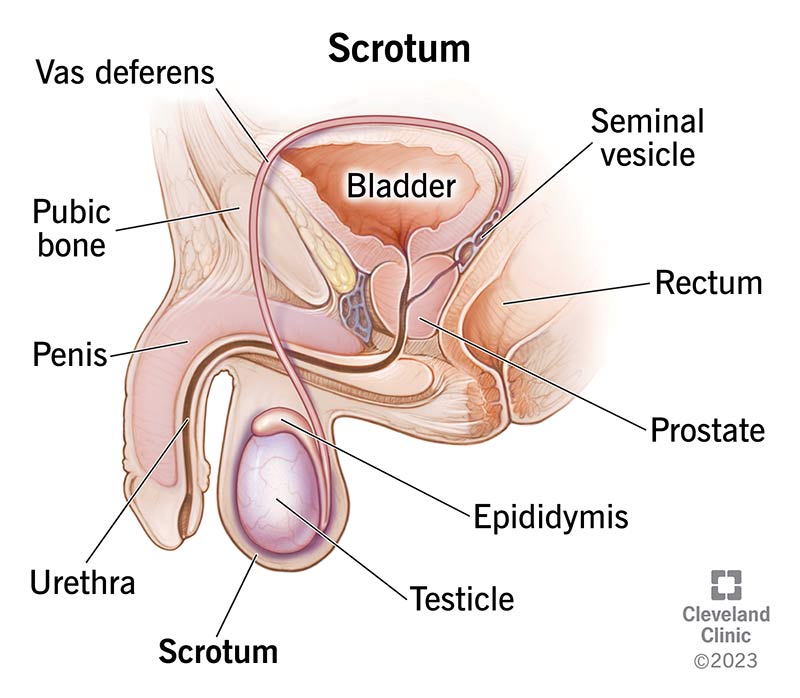Your scrotum is a thick sac of skin that surrounds and contains reproductive organs, including your testicles. Your scrotum has the important job of protecting your testicles. It also has to maintain a slightly lower temperature than the rest of your body to help with sperm production. Various health conditions can affect your scrotum, so it’s important to keep it healthy.
Advertisement
Cleveland Clinic is a non-profit academic medical center. Advertising on our site helps support our mission. We do not endorse non-Cleveland Clinic products or services. Policy

Your scrotum is an external part of the male reproductive system located below your penis. It’s a thick sac (pouch) of skin that surrounds and contains reproductive organs, including your testes (testicles). Your testicles are two oval-shaped glands that produce and store sperm. They also produce and release (secrete) hormones, including testosterone.
Advertisement
Cleveland Clinic is a non-profit academic medical center. Advertising on our site helps support our mission. We do not endorse non-Cleveland Clinic products or services. Policy
Your scrotum hangs outside of your body near your upper thighs. It’s located outside your body because it needs to maintain a slightly lower temperature than your average body temperature. The lower temperature helps regulate sperm production.
Your scrotum comes from labioscrotal swelling. This is an embryonic structure that appears during the fourth week of embryonic development.
Your scrotum is responsible for surrounding and protecting your testicles. The scrotal tissues help protect your testicles, other glands and blood vessels. Your scrotum also acts as a sort of “climate control” system for your testicles. It keeps your testicles a few degrees below your average body temperature to help with sperm production.
Your scrotum is divided into two parts by a crease called the perineal raphe. This crease looks like a line down the center of your scrotum. The perineal raphe joins your internal septum with your scrotum. The scrotal septum divides the scrotal sac into two parts. Each side of your scrotum contains the following:
Advertisement
The scrotal wall surrounds all these structures. A smooth muscle called the dartos fascia lines the scrotal wall. This muscle helps tighten and expand the skin of your scrotum as it moves up and down.
The average thickness of the scrotum is about 8 mm (millimeters).
Your scrotum is a smooth sac made of skin and muscle. It has a parietal layer and a visceral layer. The parietal layer covers the inner part of the scrotal wall. The visceral layer coats your testicles and epididymis.
Many health conditions can affect your scrotum, including:
If you notice any of the following symptoms in your scrotum or the area surrounding it, contact your healthcare provider:
Treatment for scrotum conditions will vary. Some conditions, like hydroceles, don’t require treatment unless they’re painful or large. Other conditions, like inguinal hernias, will typically require surgery to repair the issue and prevent tissue death.
Treatment for a testicular torsion may require immediate surgery to fix the problem permanently. Treatment for epididymitis may require an antibiotic or an antiviral medication. Talk to your healthcare provider about your specific condition and necessary treatment.
You can keep your scrotum healthy by following these tips:
Advertisement
Your scrotum is the thick-skinned pouch (sac) that hangs from the front of your pelvis below your penis. Your scrotum contains your testicles (testes) and has the important job of surrounding them and keeping them safe. Your scrotum is also responsible for maintaining a slightly lower temperature than your average body temperature to help with sperm production. If you have any new symptoms involving your scrotum, reach out to your healthcare provider.
Advertisement
Cleveland Clinic’s primary care providers offer lifelong medical care. From sinus infections and high blood pressure to preventive screening, we’re here for you.

Last reviewed on 03/27/2024.
Learn more about the Health Library and our editorial process.